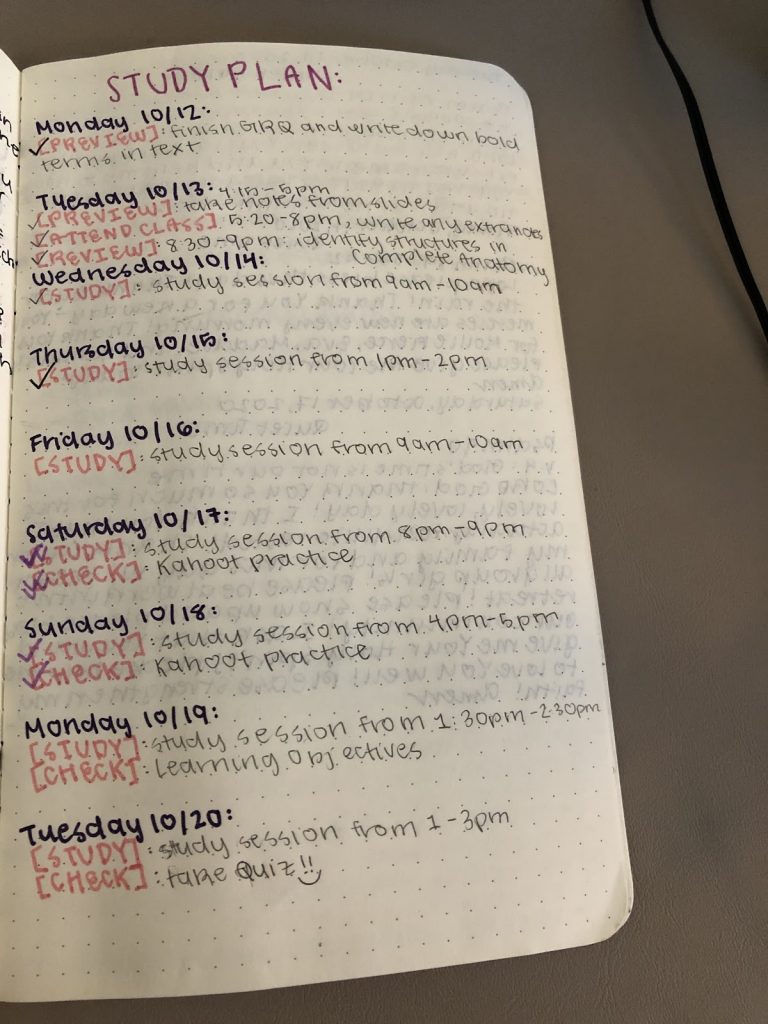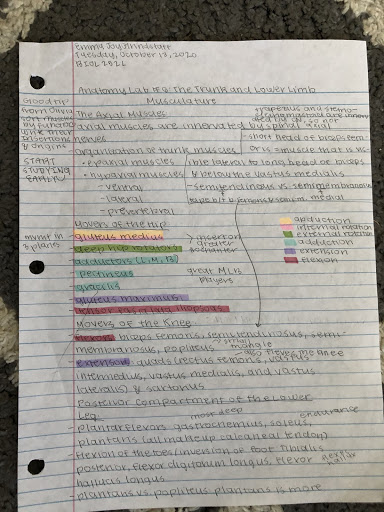A New (to Me) Learning Strategy: The Study Cycle
By Emma, a UNC Peer Tutor
This semester, my anatomy course has posed a unique challenge for me. My previous studying methods were not helping me reach the level of understanding needed to excel on the quizzes; instead, I found myself falling into the trap of reading over material in the textbook and feeling a false sense of understanding. I could recognize what I was reading or the diagrams I was examining, but my quiz grades were still less-than-ideal. Frustrated with this pattern, I decided it was time for a change in my studying habits! I visited The Learning Center’s Tips and Tools page, and I found a handout about the Study Cycle that piqued my interest. The Study Cycle seemed to be a very structured, intentional practice, and I hoped implementing it would help me understand the material better by approaching it more often.
The strategy seemed straightforward enough, with five simple steps: Preview, Attend class, Review, Study, and Check. Generally speaking, one crucial aspect of this strategy is intentionality—it encouraged me to engage with the material thoughtfully and in a variety of ways.
I often have difficulty prioritizing studying when there are assignments that are “due” in a more immediate sense, so I decided to look at my schedule for this week and block out specific times to prepare for my quiz. I figured that studying is just as essential as attending class when it comes to academic success, and that I would strive to treat it as such by putting it on my calendar like a class. I hand wrote my schedule according to the five stages of the Study Cycle in a notebook that I like to use as my planner. After making my plan and setting my goals, I began the Study Cycle process, beginning with Preview.

Preview
To preview the material, I completed my guided reading assignment before class and read the chapter in my lab text. I also took handwritten notes based on the slides that would be presented in class so that I would already have an outline and be able to jot down extra information or tips my professor shared. This part of the Study Cycle felt very natural, as the majority of my classes involve required readings before class that introduce the material before the lecture itself, so I was familiar with this process and have found it to be helpful. Going into the lecture with a basic understanding of the material made the class feel less overwhelming and gave me the opportunity to formulate any questions that I wanted to ask my professor during class.
Attend class
The next step was easy: Attend class. I attended my lab and jotted down a few more notes based on what my professor said. I already had material from the slides written down, but my professor gave some extra information that I included in the margins. My class included Poll Everywhere practice problems as well as group work, which were both very useful for reinforcing the content we were learning. Rather than passively listening and trying to absorb broad concepts, practice problems and group work let me to engage more thoughtfully with the material and learn from my classmates. I also wrote down the Poll Everywhere questions and answers in my notes.

Review
The third stage was Review, which was also easy to complete, since our Lab Assistant typically leads a Kahoot review after my professor finishes lecturing. Typically, the Kahoot questions are quite difficult for me because I don’t know the material well yet. In my other classes where there is not an integrated review component, reviewing looks different. In those cases, I typically compile a study guide of the most important things from class, write down any questions that I had and seek the answers, or go over the Poll Everywhere practice problems from class and see if I could answer them correctly.
Study
The next step was perhaps the most obvious one: Study. As seen in my schedule, I blocked out one hour every day to study. During these study sessions, I tried to focus my time on learning the various anatomical structures, how they connect to other structures, and what their function is. Some of the activities I used to study included drawing charts to categorize information, using software to visualize movements and 3D structure, and creating Quizlet flashcards and reviewing them. These studying methods were similar to how I had prepared for the last quizzes, but the scheduled one-hour blocks contrasted with my typical studying patterns. I strive to study every day starting two weeks before an exam or major assessment, but sometimes these “study sessions” consist of approximately five minutes of flipping through notes for the sake of being able to check off studying in my planner. With my Study Cycle schedule, however, I was faithful (for the most part) in doing these study sessions during the times that I had scheduled them. I found it very helpful to set aside time in my day to study as if it was a class or meeting. Sometimes, if I don’t make time to do something, it gets pushed aside until the last minute!
Check
The fifth and final step was Check. For this step, I revisited the Kahoots that my Lab Assistant used in class. I used these to assess my understanding of the material and identify areas where I needed to study more, such as how different muscles worked together. Based on my performance on the Kahoots, I targeted my studying efforts, cycling between the Study and Check steps of the cycle until it was time to take my quiz. If I missed a question on the Kahoot set, I ensured that I understood the correct answer and studied the missed concept or detail further. I took the two Kahoot quizzes multiple times each and they served as a great confidence boost when I answered questions correctly, and when I didn’t, it was a helpful reminder of what I did not yet understand.
When it came time to take my quiz, I was pleased with the amount of time I had devoted to studying, and I knew that I had met my goals in preparation for the quiz. I found the Study Cycle to be a great way to structure studying and ensure that I was engaging with the material often and in different ways. I especially loved the intentionality that it fostered. Sometimes, I tend to think of studying as a thing I do for a few days before a quiz or test, and it has been helpful to think of it more as a continuous cycle that begins long before an assessment, something to be prioritized and scheduled. The Study Cycle helped me go into the quiz confident that I had been intentional about my preparations and that I hadn’t waited until the last minute to study. I also felt that the five steps helped me break down what types of studying methods I could use and ensure that I was being active and thoughtful in my interaction with the material. That being said, I felt like I wasn’t as prepared as I could have been because I understood one unit much better than the other, and the quiz assessed both units. I think it would have been helpful for me to create a more detailed plan for studying when it came to what specific material I would review. In the future, I want to try adding more organization and structure into the Study and Check stages of the Study Cycle by breaking down the studying into units or topics. I think a more balanced approach will help me improve even more, rather than waiting to study the next unit if I already feel confident with the first. I plan to use the Study Cycle in the future, and I will keep making adjustments to make the most out of this strategy that helps me add structure to my study sessions!
This blog showcases the perspectives of UNC Chapel Hill community members learning and writing online. If you want to talk to a Writing and Learning Center coach about implementing strategies described in the blog, make an appointment with a writing coach, a peer tutor, or an academic coach today. Have an idea for a blog post about how you are learning and writing remotely? Contact us here.

